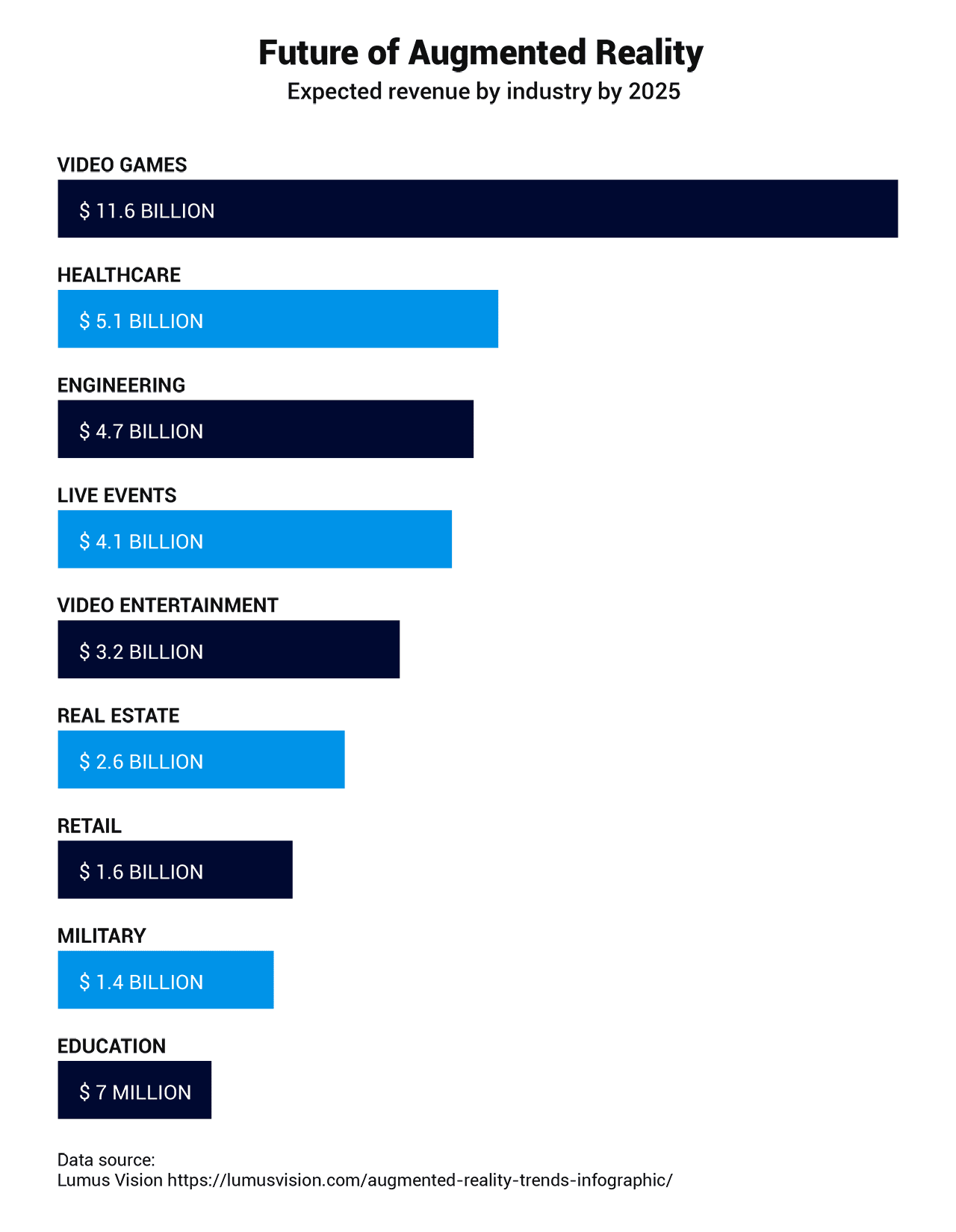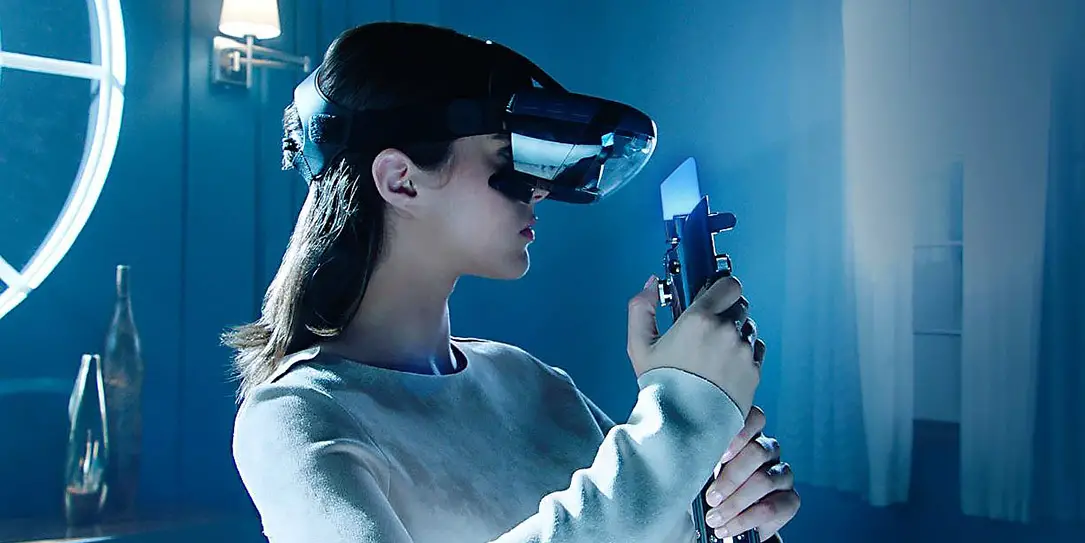Whenever we talk about Augmented, Virtual or Mixed reality, the first thing that comes to our mind is new immersive gaming technology. Even though it is very much correct, gaming is just a single aspect of these global technological advancements taking the world by storm.
The purpose behind mixed reality or the crossover of augmented and virtual reality is to create an immersive experience for individuals and businesses alike to connect the interactive and the physical world. Where Augmented and Virtual reality was incredibly impactful for the last two years of the previous decade, mixed reality has been gaining momentum recently.
These technologies not only made a difference for gamers and smartphone users but caught proper attention from emerging as well as established brands and entrepreneurs. As per a report by Statista, the global immersive technology market is estimated to grow around $6.3 billion in revenue for 2020. And even though these technologies are consequently used as overlapping terms, they have their distinct attributes making marketers look forward to the future of development in AR, VR, and MR.
- Augmented Reality or AR: leverages a smartphone camera to add digital elements to a live video or view. The modern-day hyped Snapchat lenses are a great example of AR.
- Virtual Reality or VR: is a step ahead from AR as it takes its attributes and turns them up a notch by completely discarding the outside world to create a reality-based immersion experience. Popular VR headsets and wearables like HTC Vive, Oculus Rift, or the pioneer Google cardboard are known for creating HD immersion experiences for enthusiasts.
- Mixed Reality or MR: like its name suggests combines both AR and VR. It makes the real world and digital objects interact and react to each other’s presence to create an imaginative reality-based scenario. As the technology is comparatively new, Microsoft’s HoloLens is one of the notable devices known for a visionary MR experience.
Top 15 AR, VR and MR Trends to look out for in 2020
So as AR, VR, and MR technology prepares to go mainstream this year, it will consequently bring on necessary changes for the individuals and the business world alike. Hence, let’s find out what are the projected trends that promise billions of global market revenue for the immersive technology industry.

1. Mobile AR
Augmented reality marked its estimated growth stage last year as the commercial support from big tech names like Microsoft, Amazon, Apple, Facebook, and Google poured in. These companies made serious commitments to integrate AR by creating a user base for AR-supporting mobile devices.
Given the likeness of consumers and businesses towards Apple’s ARKit and Google’s ARCore, software development kits have standardized the use of development tools. The 1.5 billion worth of revenue earning in 2019 that was brought on as the number of AR-enabled devices increased, is estimated to flourish even higher in the current year. As predicted by statistical projections for mobile augmented reality, it can go up to 2.8 billion in 2023.
2. Web AR
When it comes to the introduction of augmented reality on the web, the likelihood of Google Chrome and Mozilla Firefox are heavily engaging in the new technology. ChromeAR is a highly anticipated product for the year 2020 as it will allow users to simply log on to AR-friendly websites to access the same level of functionality as they would have done so through a specialized AR application.
The trend is in gear as the underlying objective is to make AR adoption a smooth process. 2020 is said to be the year where every web browser would have somehow integrated AR. Like Apple, Samsung, and Microsoft also take on Web AR for their browser offerings. These standards will be actively met in the near future.
3. AR-Enabled Shopping Technology
As per the BRP report, almost 50% of the consumers say that they would buy from a retailer that offers an AR-enable shopping experience. Even though not many retailers have embraced the likeness of AR technology, a separate report says that AR-enable shopping technology is the hottest retail trend up for operation. Up to 100 million retailers across the globe are expected to integrate AR-enabled shopping technology by the end of this year.
With many popular retail brands like American Apparel and Lacoste already having incorporated AR, this technological aspect is set to change how shopping works. With dedicated features on websites, apps, and enhanced physical shopping experience through smart mirrors, trial options, and smart recommendations, consumers will soon be leaving the traditional ways of shopping behind.
4. AI In AR/VR/MR
Artificial intelligence, Augmented Reality and Virtual Reality are not as new to the business world. The triumphant trio had entered the business side of things a long time ago and proved the potential of the advanced technology individually. However, recently experts are discussing the possibility of the collaborative efforts of these three technologies. The objective of the discussion is how AI in the space of AR and VR can bring on more enhancements. As AI and machine learning are a faster-growing tech sector, bringing them in combination with AR, VR and MR is a natural extension of the two. The mixture is expected to aid computers, devices, and webpages to:
- Create highly interactive workspaces
- Improve image recognition technology
- Enhance data science to deliver more congruent results
- Robust retail and mobile solutions
- AI-enhanced AR/MR-enabled healthcare solutions and tools as per Deloitte Research.
5. AR Avatars
We all are pretty accustomed to the theory of robots taking over the world and killing all human species and becoming the next kind of taking life forward. AR Avatars brought these theory-based fears much to the forefront with how human and lifelike they appeared. We all will agree to have given in the fact that Lil Miquela was indeed an animated person but turned out to be a robust AR avatar and gained popularity for being so lifelike. Therefore, such fictional characters have created such a strong appeal from the masses that companies are now looking forward to developing a virtual influencer that can act as their brand mascot for immersive marketing.
6. AR Technology in Vehicles
As self-driving, auto-pilot, self-park, and voice-activated vehicles have gained popularity, the logical next step that researchers are moving forward with is integrating AR technology in transport vehicles. Autonomous cars are becoming the next big thing in the timeline of emerging technologies. Thanks to various automotive industry leaders like Tesla, Hyundai, and Porsche, the idea of using AR technology in vehicles is slowly becoming a reality. It is expected to redefine the way people move about.
7. AR For Navigation
Navigation has been one of the most obvious uses of AR technology ever since researches found the ever-expanding potential of the technology. The new decade is expected to explore how the average consumer can get to incorporate it into their daily lifestyle. Google Maps and other navigation services from Apple have already been taking its game up a notch. With people relying heavily on the map services to move about, but now thanks to AR, the companies are looking forth to experiment with indoor navigation.
In August 2019, Google experimented with one such feature by providing a beta version AR-direction option to AR-enable devices. Users could use the option at shopping malls and airports by simply letting the feature directing the way.
8. 5G for AR/VR
5G in cellular technology is set to hit the markets for commercial usage shortly. The impact of 5G in the foreseeable future will bring an impactful difference for how consumers perceive AR/VR as of now. By offering superfast network and internet connections, the rapid pace at which we would be able to exchange information would become unreal. Experts providing cheap assignment service leveraging technology say that consumers would be allowed better data transfer to gain an enhanced virtual experience through augmented headsets and wearables.
9. Mixed Reality at Scale
Mixed reality is still in its early stage. However, that doesn’t mean that technology is not set for newer and better advancements. In terms of business, gadgets, and on an industrial level, leaving the primary developments of being used just for gaming behind mixed reality is all set to be introduced to the business side of things and be used at a bigger scale.
According to Harvard’s Mixed Reality: a New Dimension of Work survey, almost 70% of businesses say that mixed reality is going to be crucial for achieving their organization’s strategic goals. Researchers say that companies are readily going to embrace a range of productivity-enhancing, cost-saving, and safety-oriented activities, thanks to MR.
10. More Industrial Use of AR/VR/MR
Initially, when AR and VR started making waves, it was mainly in combination with the immersive gaming technology being appreciated by gamers and tech-enthusiasts alike. Then, later on, military and medical institutions were seen embracing the potential this advanced technology had concerning services provided in these public sectors. Now, as of 2020, you can expect businesses and enterprises are adopting AR, VR, and MR to suit their individual needs.
According to Tim Turcich, a senior software engineer from Bisimulations, “Organizations that couldn’t afford the high budgets demanded to integrate this technology have now set aside dedicated budgets for visualizations.”
11. Advanced Technology for Wearables
Not that we already haven’t adapted to the box cut, face-covering dimensions of Google Cardboard, but thankfully the future is much sleeker. Starting from this decade onwards, consumers can expect designs as elegant and slim and comfortable to wear like regular pair of eyeglasses. Not only will the weight and size of the wearables drop, but there will be a significant drop in power usage and price.
As the technology is going to advance, the simpler designs will be ready for adoption by industrial players than just gaming and interested individuals.
12. Optimized Marketing through MR
We have discussed this earlier in the article that at the core of its developmental dimensions, MR is combining both AR and VR for an enhanced experience of both the real and digital world. This very point has created the increased demand as consumers now understand the advantage of overlapping offline to online experiences.
The FUSE marketing group believes that mixed reality will create immersive experiences for in-person retail where consumers would be able to interact with marketing campaigns before they make up their mind to buy something. Marketers would be expected not just to sell products or promote their brand. They would also have to deliver an experience.
13. MR/VR for Defense
AR and VR have already paved their way for defense, military, and medical institutions. 2020 is high time we combine the two and use MR for its utmost potential to provide enhanced experiences to public sectors like firefighters. Virtual Reality headsets that can take-in the external environment during an emergency and provide visual guidance to firefighters will be a great way to point out where people are stuck inside a building in case of fire or building collapse.
Such technology can work immensely to bring down the risk of such public service providers putting their life in jeopardy to save people.
14. AR/MR for Enhanced Interactive Training
We all can pretty much already visualize the potential of MR technology, making our lives a hundred times easier by launching devices that cater to interactive training. As the demand and use for talent increases, it is hard for employees to interact with each employee in-person and provide one-on-one training.
With the help of AR/MR technology at leverage, employers would give immersive training focused on each individual. Experts predict that it will consequently bring up employee retention rates as employees would get on-job training readily whenever it is needed at their own time.
15. More Upscale Entertainment through AR/VR/MR
Lastly, gaming is not the only aspect of entertainment where AR, VR, or MR can make waves. It doesn’t need to stop there. From animation and motion art to full-fledged movies and 3-dimensional forums, the list can go on where AR, VR, or MR can be readily embraced and carried forward. According to Alex Shrestha a developer for VR live-streaming at oQQur, “This year we will see a lot more focus on consumers—entertainment and games”.

Bottom Line
As we have discussed throughout this article with the help of expert opinion and projected statistics, it is safe to say that virtual and augmented reality has not overstayed its welcome. The technology is very much flourishing and will continue to develop as the new decade unfolds. Having just awareness of AR, VR, and MR trends is not enough.
Companies should start preparing for a fully immersive future professionally and profitably. Where gaming is still going to remain on top of the charts, other industries are now developing strategies to undertake these emerging technologies and looking towards a new interactive and immersive future.
What do you think of augmented, virtual, and mixed reality trends in 2020? Of the three, which do you prefer? Virtual? Augmented? Or Mixed? Let us know in the comments below or on Twitter, or Facebook. You can also comment on our MeWe page by joining the MeWe social network.
Author Bio: Amanda Jerelyn is currently working as a Head of Medical Department at Crowd Writer and Trainer at Dissertation Assistance, an excellent platform that provides FreeEssayWriters. She is a modern tech-enthusiast who has done significant research on the potential of immersive technologies. You can read about it on her blog.
Last Updated on February 14, 2022.










